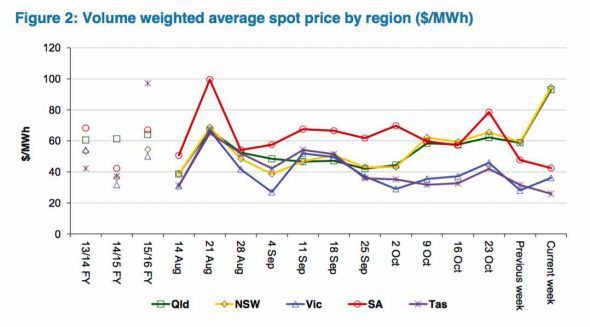Wholesale electricty prices in New South Wales and Queensland, which have two of the most coal dependent grids in Australia, have soared in recent weeks, and according to the latest official data and were more than twice the price of wholesale electricity in renewable-rich South Australia.
While much has been made of some recent big price spikes in South Australia, blamed by vested interests and ideologues on wind and solar, wholesale prices in states with little large scale wind and solar capacity have also increased.
NSW and Queensland have also witnessed spikes of up to $13,000/MWh. But while the South Australia price spikes have been sheeted back to “gaming” by the big gas generators who control the market, the price spikes in the eastern states are being blamed on actual failures of gas-fired generators.
 The AER says in its latest report – covering the week from Nov 6-12 – that all three units at the relatively new Braemar 2 gas-fired power station near Dalby tripped without explanation, at 2am on November 8, taking 370MW of capacity out of the grid.
The AER says in its latest report – covering the week from Nov 6-12 – that all three units at the relatively new Braemar 2 gas-fired power station near Dalby tripped without explanation, at 2am on November 8, taking 370MW of capacity out of the grid.
The gas plant returned to service about 13 hours later, but The Australian Energy Market Operator wasn’t convinced it was a reliable source, so it decided to invoke a “credible contingency” and imposed generation constraints on 16 different units to ensure network stability.
This had the impact of sending prices in both states up to $12,900/MWh, before other fossil fuel generators suddenly provided more “available capacity” and tried to cash in on the temporary bonanza.
A high price in one 5 minute dispatch period guarantees a high price for the entire 30 minute settlement period, which is why most users are pushing for changes to allow for a 5 minute settlement.

It is not the first time issues at gas generators caused problems in the network. In Western Australia, a sudden outage at the Kwinana plant caused outages for 150,000 households for several hours.
In South Australia, gas and diesel generators failed to provide their high-priced “black start” services after the state-wide outage, and had to wait until the extension cord to Victoria was reconnected before they could start up again.
In Queensland, however, prices will be tested again this week when the state prepares to deal with its hottest summer day in 15 years, according to some reports. Paul McArdle, writing in Watt Clarity, says the grid will be tested, and the coal-dependent state will likely rely on imports from NSW to meet peak demand.
This gives lie to another myth about renewables, that only renewable rich states need to import energy. The myth is often used by critics of Germany’s Energiewende, but the country actually exports around twice as much electricity to neighbouring France, for instance, than it imports from the nuclear dependent country.
France has become even more independent on imports from other countries, given that up to one third of its nuclear reactors were sidelined due to safety concerns.
As it is, France does not have enough capacity to meet its own peak demand and has to rely on imports to meet its needs, although it is now accelerating the rollout of renewables to reduce that dependence.

Fortunately, while Queensland has little or no large scale solar or wind farms, it does have the country’s biggest installed capacity of rooftop solar.
Those 500,000 installations were providing more than 1 gigawatt of power for much of the morning on Thursday, helping to keep prices in check as it meant less need for expensive gas fired generation and imports from NSW.







